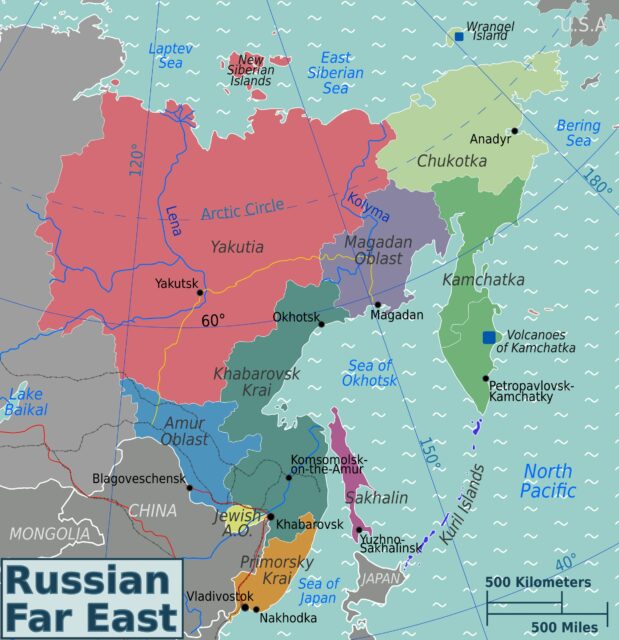Russia’s Far East and China

Geopolitical Report ISSN 2785-2598 Volume 41 Issue 1
Author: Giuliano Bifolchi
Assessment
Developing and improving the socioeconomic conditions in the Far East is of utmost importance for the Russian Federation, as it offers a substantial opportunity for economic growth and strategic influence. The continuous investments in the area, totalling around 10 trillion roubles, show a significant effort to enhance regional stability and establish Russia as a prominent player in the Asia-Pacific region. Although Beijing might be one of the key investors in the region, there is also the possibility of a conflict between Russia and China for the control and influence of the Far East’s regional dynamics and economic market.
Background Information
On July 24th, 2023, the Russian government issued a decree that approved a significant investment plan aimed at bolstering the socio-economic development of five cities in the Far East region. This initiative encompassed long-term strategies for areas surrounding Yuzhno-Sakhalinsk, Ulan-Ude, Severobaykalsk, Chita, and Tynda. The decree notably designates over 32.6 billion rubles for the improvement and restoration of infrastructure at the Korsakov seaport. Out of these allocations, a total of 7.1 billion rubles has been designated for the renovation of the National Fishery Resource facilities, while 25.5 billion rubles has been allocated for the enhancement of the Rosmorport facilities, which serve cargo and cruise ships.
In 2019, Russian President Vladimir Putin introduced a legislation that restricts tourism activities in nature reserves to only those that have minimal environmental impact, since the region hosts 23 natural reserves. This strategy outlined the blueprint for building infrastructure to support tourism by encouraging partnerships between the public and private sectors.
Geopolitical Scenario
The Russian Far East occupies a central position in Russia’s geopolitical calculus, serving as a gateway to emerging markets in Asia and offering avenues for trade diversification. The region’s development not only enhances Russia’s economic performance but also strengthens its strategic foothold in the Asia-Pacific. By investing in infrastructure and connectivity, Russia strengthens regional integration and promotes international cooperation, establishing itself as a significant influence in shaping the geopolitical dynamics of the Far East.
Chinese Interests in Russia’s Far East
For years, Russia’s far eastern Khabarovsk province has attracted significant attention from Beijing because of its abundant energy and mineral resources, along with its strategic position as a potential land-based energy supply route to China. However, historical complexities stemming from 19th-century treaties have hindered Chinese access to key resources in the region.
Despite this, recent shifts in bilateral dynamics have seen Moscow increasingly turning towards China for economic support and partnership, particularly in the face of strained relations with the West because of the Ukraine conflict. A substantial increase in Chinese investment in the Russian Far East evidences this shift, with Chinese state companies financing a significant portion of infrastructural projects and becoming the region’s largest trading partner.
Leveraging the Power of Siberia pipeline, both countries are actively working to decouple from Western energy supply chains, with Russia emerging as China’s top energy provider and offering discounts on crude oil, resulting in substantial savings for Beijing.
Risk Analysis
Alongside this growing cooperation, there are also instances of divergence between Russia and China. The fear of Western sanctions has led to the withdrawal of major Chinese tech companies and state banks from Russia, showing potential challenges in the bilateral relationship. Despite efforts to bolster economic ties, concerns remain regarding the impact of geopolitical factors on the long-term sustainability of the partnership.
The Russian development of the Far East serves as a strategic response to counter China’s rising role in the region. As Moscow promotes its economic initiatives, tensions with Beijing may escalate, leading to potential confrontation over strategic interests and influence. The region’s susceptibility to external interference and geopolitical manoeuvring poses risks to regional stability and security, necessitating careful navigation of power dynamics to mitigate potential conflicts and safeguard national interests.
Investment Opportunities and Challenges
Foreign companies stand to benefit from the development of the Russian Far East through opportunities for economic growth, regional integration, and international cooperation. Enhanced infrastructure and demographic revitalisation measures create avenues for investment, job creation, and improved living standards. However, challenges such as overdependence on external actors, unequal trade agreements, and geopolitical uncertainties pose risks to investment viability and require careful consideration amidst the backdrop of potential confrontation between Russia and China.
Read also | Ukraine conflict, natural gas pipelines and Russian strategy |
For further information and reports on this issue, contact us at info@specialeurasia.com.
